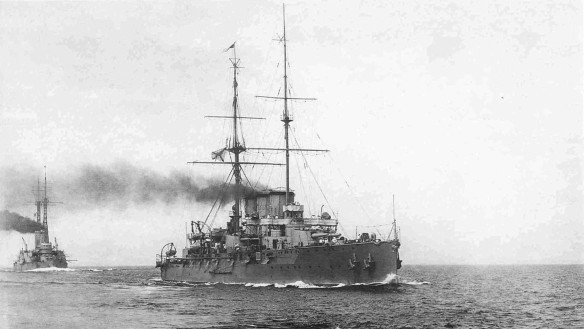
Between 1889 and 1893, Russian naval expenditures increased 64 percent. On the whole, Russia devoted its resources to the construction of battleships. The Russians persisted in the construction of armored cruisers rather than protected ones, but these ships numbered only three in this period. Two, Rurik and Rossiya, were large and commissioned in 1895 and 1897 respectively. The Rossiya was the larger, displacing 13,675 tons with a hull that measured 480 feet, 6 inches by 68 feet, and mounted four 8-inch guns and 16 6- inch weapons on the broadside below the upper deck. This ship and Rurik were the impetus for the British construction of the Powerful class for fear of the potential damage that the Russian ships might cause to British commerce in time of war. In truth, the British had little to fear from these ships. Neither were very good designs, being poor steamers, and the disposition of the guns was so badly arranged that French officials believed it “had been stuck on as an afterthought.” 12 These rather poor ships were only augmented by one protected cruiser. Russian naval officials simply believed in the superiority of the battleship over all else.
Italy’s and France’s slight programs appeared enormous in comparison to cruiser production in imperial Russia. The country had ceased to be a major naval power with its defeat at Tsushima, slipping from the third most powerful naval force to sixth place. Subsequent naval construction was slow as a result of the strain placed on Russia’s economy by the war and the diversion of the government’s attention to deal with internal social and political unrest produced by the hardships of the conflict. Russia, consequently, produced only one cruiser before 1908. This vessel, the armored cruiser Rurik, was one of the best ships of its type ever built and a tribute to the ability of Russian design [1]. Completed in 1908, the warship’s hull measured 529 feet by 75 feet and displaced 15,190 tons. It mounted four 10-inch guns in two two-gunned turrets located fore and aft that were supplemented by a secondary battery of eight 8- inch guns, mounted on the ship’s sides, and two 18-inch torpedo tubes. The Rurik was well-armored with a belt of a maximum thickness of 6 inches and 8-inch armor on the turrets and conning tower. In addition, there were two armored decks—the main deck and lower deck—that protected against plunging shellfire. Its triple expansion engines could produce a maximum speed of 21 knots. The Rurik served as one of the newest units of a fleet that was only a shadow of its former strength in 1904. Russia would not regain a position of prominence at sea for the next 50 years.
The Rurik and the large Japanese armored cruisers exhibited a trend toward increasingly large vessels with more powerful batteries. They represented the continuation of a type of warship that appeared after Tsushima to be the penultimate cruiser design in terms of potency. These vessels, however, and others that were still under construction in the shipyards of several other world naval powers, were rendered obsolete in 1908 when a new type of warship burst onto the naval scene that represented the zenith of the quest to create the most powerful and versatile cruiser possible.
[1] Rurik is unusual in that she was built by Vickers in Barrow in Furness, England. She was laid down in August 1905, launched on 4 November 1906, and completed in July 1909. The Russian Navy was not usually a customer of British shipyards. She was named in honour of Rurik, the semi-legendary founder of ancient Russia.
Unlike her previous namesake, Rurik (1892), she has been described as one of the best armoured cruisers built, with advanced sprinkler protection for the magazines. She was designed by KA Tennison and AP Titov, and the contract was arranged by Basil Zaharoff. The ship had a prolonged work-up while defects were rectified.
There was a plan to build two more ships in Russia, but this was cancelled after the first battlecruiser, HMS Invincible, entered service.